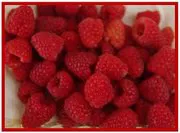 The increasing demand for high-quality foods in terms of sensorial quality and safety, has showed the current consumer trend that consumers prefer ready-to-eat foods with high nutritional value and low energy, without chemical additives or preservatives.
The increasing demand for high-quality foods in terms of sensorial quality and safety, has showed the current consumer trend that consumers prefer ready-to-eat foods with high nutritional value and low energy, without chemical additives or preservatives.The functional value of raspberries is well known; red berries are appreciated for their high antioxidant activity that is beneficial for human health in preventing free-radical formation. However, produce consumed raw, like raspberries, can be a vehicle for the transmission of human pathogens.
Food radiation is one of the few technologies able to preserve food quality and safety; it is a way to control pathogens without significantly altering sensorial properties. Food radiation is a physical and nonthermal technology, also known as cold pasteurization, which is based on the ambient gamma ray emission directly on food during final packaging, reducing the risk of cross contamination until the food is consumed by the final consumer.
Portuguese scientists have evaluated the effects of gamma radiation on fresh packaged raspberries testing different gamma rays doses (0.5; 1.0; 1.5 kGy). After radiation, the packaged raspberries were stored at 4°C for 14 days. Before and after treatment, the scientists performed microbiological analyses and the evaluation of the total phenol content, antioxidant activity, physicochemical parameters (firmness, color, pH, soluble solids, acidity) and sensorial parameters.
Microbiological results showed that the initial microbial load was 104 CFU/g in non-irradiated samples and this value increased during storage; while in irradiated berries, especially at 1.5 kGy, the microbial load was 1 log unit lower and the value remained constant during the storage period.
Results on quality showed that the radiation increased phenolic compounds and antioxidant activity for 7 days of refrigerated storage; while no differences in physicochemical and sensorial properties were found amongst the irradiated and non-irradiated berries, with the exception of firmness, which was significantly reduced by the radiation treatments.
In short, this study showed that the gamma radiation at 1.5 kGy does not have a negative impact on raspberry sensorial quality and it can reduce by 1 log unit the microbial load; however the scientists highlight the necessity of further studies to understand the real beneficial effects of radiation technology on raspberries.
Source: Cabo Verde S., Trigo M.J., Sousa M.B., Ferreira A., Ramos A.C., Nunes I., Junqueira C., Melo R., Santos P.M.P., Botelho M.L., "Effects of gamma radiation on raspberries: safety and quality issues", 2013, Journal of Toxicology and Environmental Health, Part A, Vol. 76, pagg. 291-303. Further info: http://www.ncbi.nlm.nih.gov/pubmed/23514071
